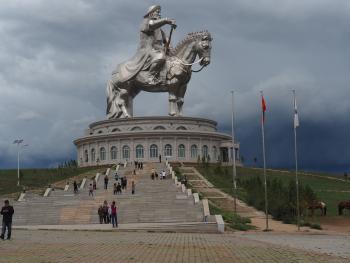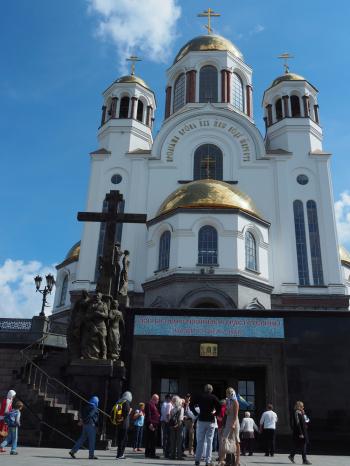Crossing Russia in luxury on the Trans-Siberian Railway
This article appears on page 40 of the May 2018 issue.
The first time my wife, Arlene, and I saw Russia was on a 2-day stop in St. Petersburg on a Baltic cruise. A cruise might not be the best way to get deep insight into a country, as each stop permits one to have only what amounts to a cup of coffee in a particular place, but St. Petersburg was so full of culture and history that it whetted our appetites, making us want to return. And so we did, on a 2016 land trip with Overseas Adventure Travel that visited the Baltic States (Lithuania, Estonia and Latvia) and included St. Petersburg and, on an optional extension, Moscow.
Unlike for our cruise stop, we needed to get visas from the Russian Federation for the land trip. Much to our surprise, we each received a 3-year, multiple-entry visa.
Getting the visas was a somewhat complicated affair, so once we had them, we decided to return to see as much of Russia as we could. And what better way than to take the Trans-Siberian Railway across the wide expanse of Russia, from Siberia to Moscow?
The plan
There are many trains that traverse Russia, and the cost of travel on the different trains varies widely. We decided on a private train because the accommodations offered the amenities Americans would expect and the travel experiences were what we wanted.
After researching both the public and private trains, we chose the Golden Eagle. We had a choice of direction of travel, and we chose the east-to-west (Vladivostok to Moscow) itinerary because it included one more stop due to the numerous time changes (seven time zones).
We booked Gold-level passage on the train, which included a private compartment with its own bathroom and shower. The beds were bunk beds, and although the Golden Eagle described the lower bunk as a double bed, we found it most impractical for two people and opted to use both the upper and lower bunks. Naturally, Arlene got the lower bunk and I got to climb up a small ladder each night to the upper bunk. (It really wasn’t bad at all.)
Booked through MIR Corp. (Seattle, WA; 800/424-7289, mircorp.com), the 14-day trip cost $20,595 per person, which included a Russian visa fee of $243 per person. (MIR refunded those fees to us because we already had visas.) Premium-economy round-trip air from New York’s JFK on Cathay Pacific (and continuing on Finnair) came to another $2,620 per person.
We added an extra two nights in Vladivostok, which included a walking tour of the city as well as a trip to see the Amur (Siberian) tigers at a Siberian preserve, for a total additional cost of $610 for both of us.
At each stop, there was a guided tour and, where necessary, a bus to transport us. All guide services and tours at every stop were included in the price of the trip, as were all tips.
Gold Service on the Golden Eagle included three meals each day, either in the dining car, where cocktails were part of the package, or in a local restaurant if we were out on tour. Wine was provided at dinner.
Pre-trip sights
We arrived at Vladivostok on Aug. 4, 2017, after a 19½-hour flight from JFK and reached our hotel at approximately 5 a.m., having just enough time to shower and eat breakfast before we began our walking tour.
We met our guide, Inga, for a tour of the Old Town, which covered essentially the neighborhoods in which Asian migrant workers lived from the time of the mass migrations that began in the late 1800s. The area, then known as either the Chinese District or Japanese District, could be accessed by walking through underpass entries from the broad main street that was once a major market street but is now a pedestrian mall. There were wooden houses, each with a ground floor of shops (now boutique restaurants or cafés).
We walked along the seaside, where there were many stands to purchase food, souvenirs, clothes and sundry other items.
The next morning, Inga picked us up for a visit to the Utyos Wildlife Rehabilitation Centre, located in the forests of the Ussuri taiga, approximately two hours outside of Vladivostok, to see the Amur tigers.
At the beginning of the last century, tigers were common in the Vladivostok area. However, their natural range is now much farther north.
The center contained tigers as well as deer, boars and bears, all either orphaned or disabled, so none could be returned to the wild. We walked on grated walkways high above the spacious areas provided for the animals to essentially range free, and it was the humans who were effectively caged.
Life on board
Our official tour began the next day in Vladivostok as we explored various city buildings and landmarks before continuing to the station to board the Golden Eagle. There, we were greeted by a brass band, and all the uniformed car attendants were holding signs for the various carriages. We were served champagne prior to boarding and, once on board, met Alexi, one of two attendants (the other was Natasha) assigned to our car, both of whom provided 24-hour service. We easily found our cabin, as every cabin had a nameplate with each guest’s name outside.
Arlene and I settled into our cabin, which would be our home for the next 14 days (5,770 miles). Although shelf and closet space was limited, we managed to fit all our clothes and belongings into the closet and the various cubbyholes that were available. We did have a much-larger-than-expected bathroom and shower, which proved to be quite utilitarian and comfortable.
Our suitcases were kept in storage spaces at the end of our car, but they could be brought to us if needed.
Dinner in the dining car was a leisurely affair, served on fine china, with wine constantly being poured into our crystal glasses by the very attentive waitstaff.
Seating was unassigned, but there were ample seats available no matter when during the meal we arrived. This was especially delightful, as we got to sit with different guests at every meal.
After dinner, we would relax in the bar car, chatting with our fellow travelers. Available all day, the bar car featured a piano player and comfortable couches.
After our first night on the train, we arrived after breakfast in Khabarovsk, founded in 1858 as a military outpost on the banks of the Amur River. Our brief city tour included a stop at the Khabarovsk Regional Museum, which introduced us to the geography of the Russian Far East.
Travel time on the train was broken up by lectures on Russian history, Russian language lessons, films or just relaxing on board. We didn’t lack for things to do, which was critical, as the next two days were spent entirely on the train.
At the end of the second day, around 9 p.m., the train exited Russia and we had to have our passports stamped. This was done cabin by cabin. After that, the train entered Mongolia, and the process was essentially repeated by Mongolian authorities at around 12:35 a.m. We didn’t mind having our sleep interrupted for this check, as it was a unique experience and an exciting part of the journey.
Mongolia and back
We arrived at Ulaanbaatar the next morning and debarked for a day of sightseeing that included Terelj National Park, with an enormous statue of Genghis Khan, the Gandan Buddhist monastery, lunch in a local ger (yurt) and a display of Mongolian wrestling, horse racing and archery. Since we missed the Naadam Festival by a week, the performance was a repeat of some of the festival activities, arranged just for us.
Crossing back into Russia, we soon arrived at Ulan-Ude to visit the Old Believers, descendents of religious dissidents who split from the Russian Orthodox Church in the 17th century and were exiled to Siberia.
Our next stop was Lake Baikal, the largest freshwater lake in the world by volume. Our train switched to the Lake Baikal rail branch, no longer an active transport rail line, as people can travel from the nearest city, Irkutsk, by highway in under an hour. The trains that traverse this branch are tourist trains, such as ours.
An old steam engine was hitched to our train to pull it to the lake, where the most adventurous in our group stopped for a swim in the 40°F water. I managed to get in up to my knees. (Those of us who dared even that were treated to a warming shot of vodka.)
At Port Baikal, we departed to visit the Lake Baikal museum and aquarium, then were given a choice of either going on a hike up Mount Chersky or visiting the Taltsy Museum of Wooden Architecture. Arlene and I opted for the museum, which was a series of traditional Siberian wooden dwellings, some dating back several centuries.
Our day ended with an elaborate barbecue at a site by Lake Baikal. We feasted on omul (a local fish), pork, chicken and lamb chops and watched the sunset as the day drew to a close.
In Irkutsk, a relatively large city referred to by residents as the “Paris of Siberia,” we visited a private dacha, or country house, where a local family prepared lunch for our group from the produce they had grown, themselves. In the afternoon, we spent time at the Decembrists Museum, housed in the former mansion of Prince Sergei Volkonsky, one of the thousands of Russian noblemen exiled to Siberia in the 1800s.
After another travel day, we stopped at Novosibirsk, where we were again given a choice of excursions — this time, either to tour the railway museum or the geological museum at the University of Novosibirsk. We opted for the geological museum, where we saw colorful samples of various gems and minerals.
After a day in Yekaterinburg, our trip ended in Moscow. The group toured the Kremlin, went inside St. Basil’s Cathedral and visited the Kremlin Armoury. The Armoury is a “must see,” and the lines for entry are usually long and it’s very crowded, but the Golden Eagle arranged for us to have an after-hours tour, allowing us to view all the exhibits without the usual crowds.
We saw old armor, artifacts used by many of the former tsars, a wardrobe of gowns worn by Catherine the Great, Fabergé eggs and exhibits of personal armaments.
The night ended with a farewell dinner, where we said our good-byes, as we all were leaving the next morning.
Taken in most luxurious circumstances, this rail journey provided an eye-opening experience of much of Russia. Traveling over the vast expanse of the country, we came away with a real appreciation of the true Siberia — not a desolate wasteland but a land of virgin birch forests and untamed rivers — and for its people, who we found friendly and welcoming.
Arlene and I have taken many trips, but this one ranks as one of the best.




